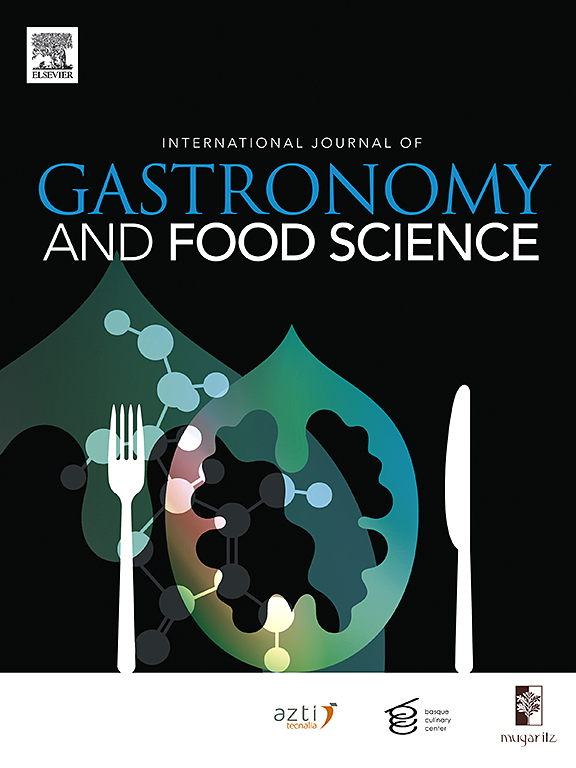消费者接受小米作为食物来源的影响因素
IF 3.2
2区 农林科学
Q2 FOOD SCIENCE & TECHNOLOGY
International Journal of Gastronomy and Food Science
Pub Date : 2025-03-23
DOI:10.1016/j.ijgfs.2025.101171
引用次数: 0
摘要
确保粮食安全和可持续性对于支持今世后代至关重要,同时最大限度地减少对环境的负面影响。地球上提供了超过25万种可食用植物,但人类已经变得依赖于三种主要作物:小麦、玉米和水稻。未充分利用的作物品种有可能缓解地球资源紧张,同时提供营养均衡的替代食物来源。自从农业实践出现以来,传统谷物一直是人类饮食的一部分,但现在许多谷物被认为是被遗忘的食物。小米是一种传统谷物,其消费历史可以追溯到宋朝(公元960-1279年)。在西方社会,小米是一种未被充分利用的食物来源,但它是一种可靠、可持续和高营养的作物,有可能缓解粮食安全和支持健康的消费模式。为了有效地将小米纳入当前的饮食行为,需要对消费者接受替代食物来源的决定因素有更深入的了解。本研究采用定性方法来评估个人、社会、文化、经济和心理因素对英国消费者尝试、利用小米并将其纳入当前饮食模式的决策过程的影响。通过对消费者进行焦点小组调查,确定利他主义价值观、利己主义价值观、习惯形成价值观、条件价值观和功能价值观的影响因素。本研究提供了对英国消费者接受小米作为食物来源的影响因素的理解,并将对实践和政策的发展感兴趣,以支持促进可持续食品系统倡议和健康饮食选择的战略。本文章由计算机程序翻译,如有差异,请以英文原文为准。
Influencing factors towards consumer acceptance of millet as a food source
Ensuring food security and sustainability is critical to support present and future generations, while minimising negative environmental impacts. The planet provides over 250,000 edible plant species yet humans have become reliant on three main crops: wheat, maize, and rice. Underutilised crop species have the potential to alleviate the strain on the planet's resources, while providing nutritionally balanced alternative food sources. Heritage grains have been part of the human diet since the advent of agricultural practices, but many are now considered forgotten foods. Millet is a heritage grain with consumption history dating back to the Song dynasty (960-1279CE). In western society millet is an underutilised food source, yet is a reliable, sustainable, and highly nutritious crop that has the potential to alleviate food security and support healthy consumption patterns. To effectively integrate millet into current dietary behaviours greater understanding of the determinants of consumer acceptance of alternative food sources is required. This study takes a qualitative approach to assess the personal, social, cultural, economic, and psychological factors influencing British consumer decision making processes to try, utilise, and integrate millet into current dietary patterns. Consumer focus groups were conducted to identify influencing factors relating to altruistic, egoistic, habit forming, conditional and functional values. This research provides an understanding of the influencing factors associated with consumer acceptance of millet as a food source in the UK and will be of interest to practice and policy to support the development of strategies to promote sustainable food system initiatives and healthy dietary choices.
求助全文
通过发布文献求助,成功后即可免费获取论文全文。
去求助
来源期刊

International Journal of Gastronomy and Food Science
Social Sciences-Cultural Studies
CiteScore
5.30
自引率
10.50%
发文量
170
审稿时长
45 days
期刊介绍:
International Journal of Gastronomy and Food Science is a peer-reviewed journal that explicitly focuses on the interface of food science and gastronomy. Articles focusing only on food science will not be considered. This journal equally encourages both scientists and chefs to publish original scientific papers, review articles and original culinary works. We seek articles with clear evidence of this interaction. From a scientific perspective, this publication aims to become the home for research from the whole community of food science and gastronomy.
IJGFS explores all aspects related to the growing field of the interaction of gastronomy and food science, in areas such as food chemistry, food technology and culinary techniques, food microbiology, genetics, sensory science, neuroscience, psychology, culinary concepts, culinary trends, and gastronomic experience (all the elements that contribute to the appreciation and enjoyment of the meal. Also relevant is research on science-based educational programs in gastronomy, anthropology, gastronomic history and food sociology. All these areas of knowledge are crucial to gastronomy, as they contribute to a better understanding of this broad term and its practical implications for science and society.
 求助内容:
求助内容: 应助结果提醒方式:
应助结果提醒方式:


